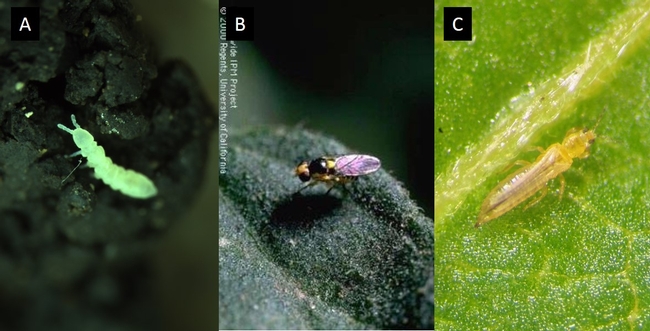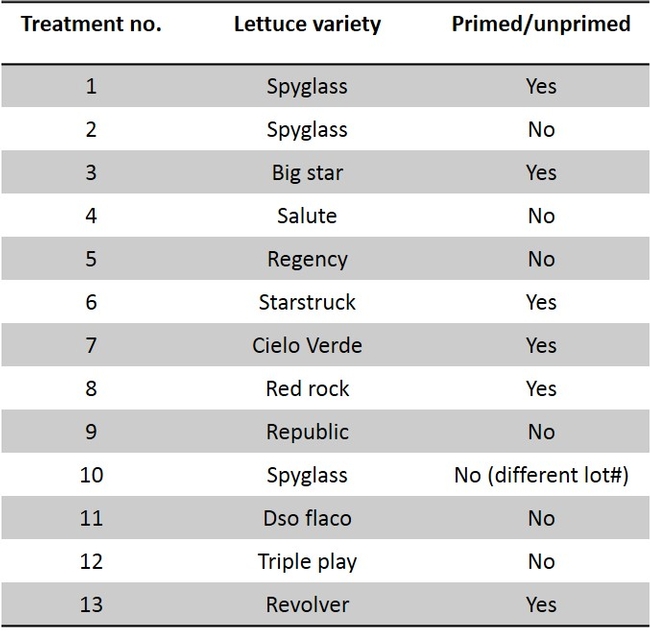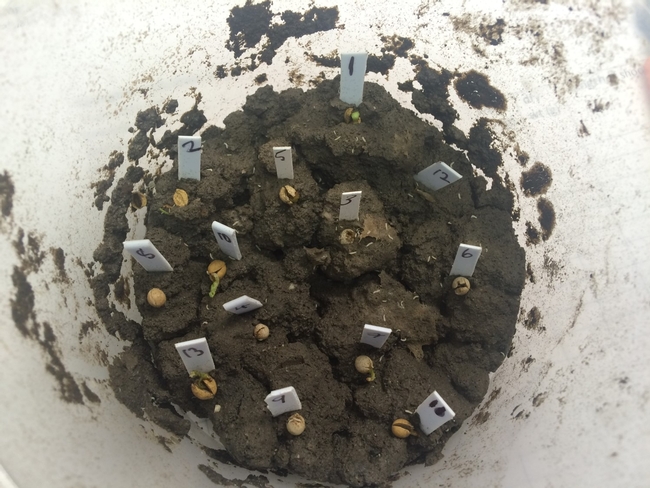A series of laboratory and field studies were conducted to determine if the insecticides coated lettuce seeds are an option to control key lettuce pests in the Salinas Valley: springtail (Protaphorura fimata; Fig. 1A), leafminers (Liriomyza spp.; Fig. 1B) and western flower thrips (Frankliniella occidentalis; Fig. 1C). In addition, a laboratory test was conducted to determine if “primed” lettuce seeds reduced springtail feeding damage.
Springtails. Springtail (P.fimata) is soil dwelling primitive arthropod primarily attacks germinating lettuce seeds, reducing the plant vigor or death, which cause patchy or area-wide stand loss. Most springtails possess a forked organ (furcula) in the rear-end, which is extended forward and backward to jump; hence, the common name, springtail. However, the springtail species, sampled from lettuce fields causing the stand loss, does not have furcula. This means it cannot jump.
The head lettuce seed ‘Regency' was coated with clothianidin, thiamethoxam, and spinosad (Table 1). The seeds were coated by Dr. Alan Taylor at Cornell University and coating technique mirrored commercial seed coating procedure. Laboratory studies were conducted in containers with springtail (P. fimata) infested soil. The data show that all three insecticides spinosad, clothianidin and thiamethoxam treated seeds significantly reduced the incidence of springtail feeding injury when compared with untreated seeds. Among insecticides, superior performance in efficacy was noted in the following order: clothianidin > thiamethoxam > spinosad (Fig. 2). Two field trials were conducted against springtails using the same seed treatments, however, the springtail pressure was so low that conclusive data were not obtained. Clothianidin (NipSit) in particular, is now registered on head lettuce and could be used for springtail control. This is an important information in that springtails attack the germinating seeds of lettuce especially in the spring time. During spring, we get some rain showers and the wet conditions in the field after planting makes insecticide application along seed line almost impossible. If the insecticide coated seeds are planted, the grower or PCA could avoid at-plant insecticide application which is typically targeted toward springtails. Application of insecticides such as neonicotinoids and pyrethroids along the seed line will protect the germinating seeds from springtail feeding. More field studies will be conducted in the following years to validate these results in the field.
Studies were also conducted to determine if there are any varietal effects exists (Table 2). The much needed attribute for springtail control is faster seed germination so that the springtail would not get sufficient time to feed and cause seed mortality. “Primed” lettuce seeds are used for uniform and a quick germination (cut short 2 to 3 days than “unprimed” seeds). “Primed” and “unprimed” seeds were evaluated to determine if the quick seed development would reduce springtail damage. Data show that germinating “primed” seeds were impacted with springtail feeding affecting their germination and were not different from the “unprimed” seeds when the springtail pressure was moderate to high (Fig. 3). The seeds used for this experiment were from same seed lot (“primed” and “unprimed”) for a lettuce variety. Also, there was no clear variety difference in springtail feeding damage.
Leafminers and western flower thrips. The leafminer eggs are laid within the surface layer of the leaf. The eggs hatch within couple of days and the maggots mine through the surface layer of the leaves. The egg laying and maggot mining creates stippling and mining injuries which make the leaves unmarketable. Although UC recommends few insecticides such as Agri-mek (Abamectin), Trigard (Cyromazine), Aza-direct (Azadirachtin) and Entrust (Spinosad), the management of leafminers are primarily relied upon on Agri-mek applications.
Thrips is another of the major pest of lettuce, and combination of direct feeding injury and viral disease [thrips-transmitted tospoviruses [Impatiens Necrotic Spot Virus (INSV)] can cause significant losses in lettuce production. In addition, because most of the export markets have set higher standards on prevalence of live and dead thrips in the produce, the lettuce industry is constantly battling ways to significantly reduce thrips in the produce targeted for export.
A replicated-field trial was conducted to determine the efficacy of seed coated insecticides (Table 1) on leafminers and western flower thrips incidence and their infestation. The results show that insecticide seed coating may not be an effective option for leafminers and thrips control in head lettuce (Table 3 and 4) under the conditions this experiment was conducted. There was no reduction of leafminer or thrips feeding with insecticide coated seeds compared with untreated control. Further evaluations under varying conditions might be necessary to validate the consistency of these results.






